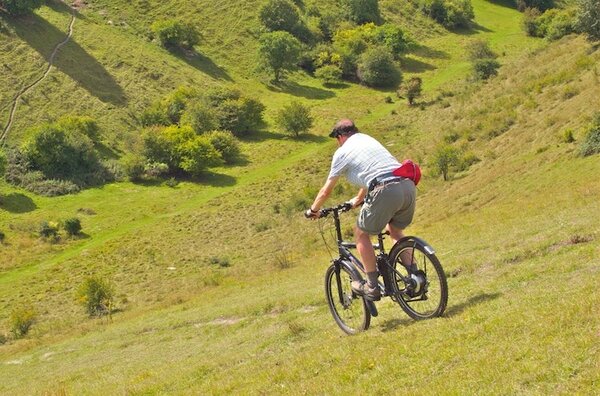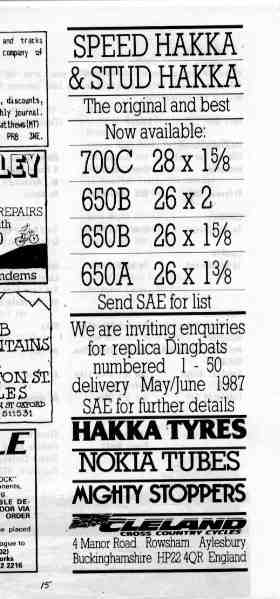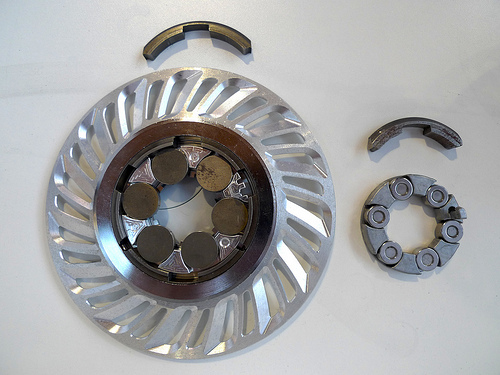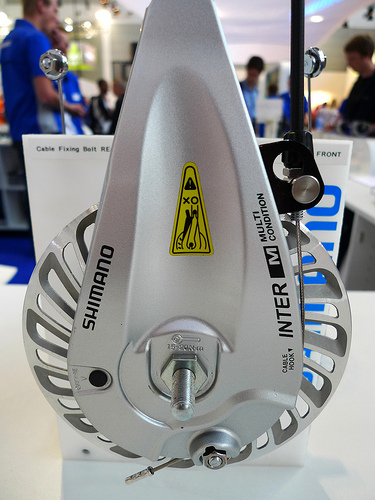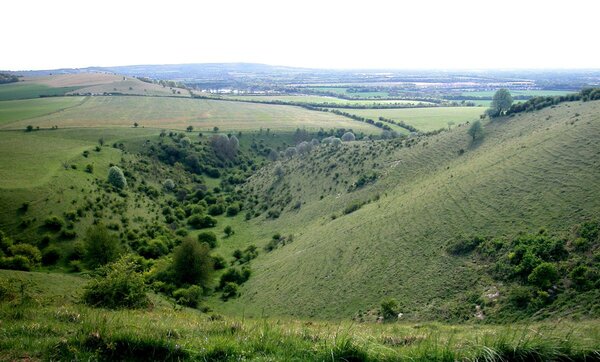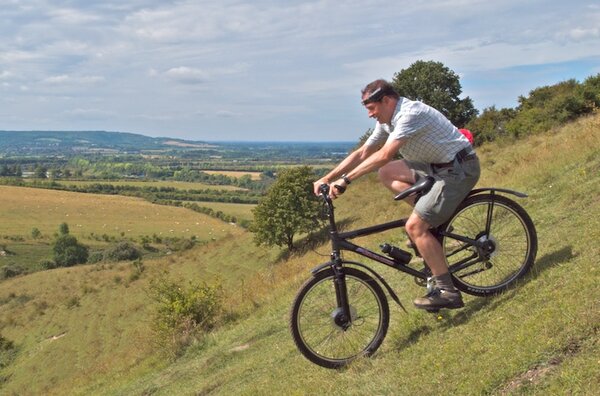You are using an out of date browser. It may not display this or other websites correctly.
You should upgrade or use an alternative browser.
You should upgrade or use an alternative browser.
Retro 29ers/700c MTBs?
- Thread starter Joe of Loath
- Start date
- Feedback
- View
The surface area of hub brake pads is much bigger but the main reason that they last so long is because grit cannot get inside to grind away at the pads. Nor can grit damage the brake mechanisms.Ductape":379g15j2 said:.
I would guess the brake pad wear is about the same. One is just over a much larger surface area.
In some gritty wet conditions you can wear down a set of disk brake pads in a couple of days riding.Ductape":379g15j2 said:.
Why haul around 25 years of brake pad when you can just add new once a year or so.
Many military and off road vehicles still use them. Disks cool faster because the airstream flows over both sides and even through the middle with vented disks. Some modern vehicles have disks at the front and hubs at the rear because the rear hubs are in a stream of dust and grit thrown up by the front tyres.Ductape":379g15j2 said:.
For the most part quality Cars, motorcycles, and bicycles have left the drum brake behind. Profit margin?
Shimano's 80mm Roller-Brakes are the best hub-brakes currently available. The braking surfaces are under immense pressure but coated with high temperature grease. Because of this they are ultra smooth and silent with no sudden snatching even under the heaviest braking. They have large finned cooling disks that look similar to disk brakes. The modulation is beyond that of any current disk brakes creating what is effectively an anti lock brake system. They are the only brakes that I trust to get me safely down a local hill. None of my friends who use disk brakes have managed to ride far down it, and there is no run out at the bottom so you don't dare let your speed build up.
Attachments
- Feedback
- View
What tire thing?hollister":1rixyevl said:Is this like the tire thing?
The Cleland Hubs were 70mm in diameter and originally made for use on a wide variety of French mopeds. The Highpath hubs are 90mm in diameter and were made by Highpath themselves using a similar floating cam type mechanism.hollister":1rixyevl said:Who made the hubs, Graham?
I must be lucky then because I have used hydraulic disc brakes on my modern bikes since 2001. Never had an issue yet, and I ride in the rain and muck from October to July.
More focused on vintage stuff than modern but I will make a trip over to Pinkbike to look for the knarley DH bikes built up with the latest drums Shimano has to offer.
Pictures never look as steep as the real world, but from the appearance of that pic, I would feel pretty comfortable descending it on any of my bikes (drum, canti, V, or disc). I believe the only time I felt really uncomfortable on a downhill was back in 1990 the time I was flying down Denny Way off Capital Hill with a friend on the tandems initial voyage. 40+ mph with an intersection and cars lined up at the bottom. Started pulling brake harder and harder until the XT pads started coming apart in chunks. Fortunately the light turned green.
More focused on vintage stuff than modern but I will make a trip over to Pinkbike to look for the knarley DH bikes built up with the latest drums Shimano has to offer.
Pictures never look as steep as the real world, but from the appearance of that pic, I would feel pretty comfortable descending it on any of my bikes (drum, canti, V, or disc). I believe the only time I felt really uncomfortable on a downhill was back in 1990 the time I was flying down Denny Way off Capital Hill with a friend on the tandems initial voyage. 40+ mph with an intersection and cars lined up at the bottom. Started pulling brake harder and harder until the XT pads started coming apart in chunks. Fortunately the light turned green.
- Feedback
- View
No I am not wording things to mislead anyone. Nowhere have I said or implied that Cleland made their own hub brakes. You appear to be are imagining things. The only comments I made regarding the hubs used on Cleland bicycles before youhollister":7loetvnj said:The tire thing where you kept calling them Cleland tires, but they aren't
You're doing it again now with the hubs. You're wording things in a misleading way
"2/Use floating input cams like those used on Cleland and Highpath bikes. Here the activating cam can move side to side between the brake shoes and so self-centres to compensate for any difference in brake shoe wear."
And in my reply to your question "Who made the hubs, Graham?"
"The Cleland Hubs were 70mm in diameter and originally made for use on a wide variety of French mopeds. The Highpath hubs are 90mm in diameter and were made by Highpath themselves using a similar floating cam type mechanism."
I admit that the phrase "The Cleland Hubs" could be read as Cleland made the hubs, instead of the intended, used the hubs. However, this would only make sense if they also supplied the hubs to the entire French moped market.
If I wanted to state that Cleland made their own hubs I would have done so, as I did with Highpath.
The hubs Cleland used were branded as Leleu. However identical hubs are to be found re-branded as their own, by the numerous European moped manufacturers that used them. When Cleland sold them separately they were branded as Cleland' 'Mighty Stoppers'.
As with the tires, when companies import, export, distribute or advertise products, they often claim or even re-brand the product as their own.
Do you think that Specialized actually make all the products they sell?
Do you think that a Walmart' Coca-Cola is made by Walmart?
Why should a product imported, exported, distributed or advertised by Cleland' and sub-sequentially branded as sold by Cleland mislead people into believing that Cleland made it themselves? Especially as with the tires, when they also refer to the makers name and brand in their adverts?
Attachments
- Feedback
- View
The truth here is that Geoff Apps influenced others as much by sourcing and supplying parts as he did by designing and manufacturing bicycles. Had he not discovered the French Leleu brakes then Highpath would never have set about improving them. If he had not supplied 650b Nokia Hakkapeliitta tyres to Gary Fisher and Charlie Kelly then Marin framebuilders like Tom Ritchey would not have made any 650b tyred mountain bikes in the early 1980s. And unless another source for Hakkapeliittas in California can be proved it is highly probable that the 700x47c found by Gary Helfrich and Bruce Gordon would not have inspired Gordon to have the Rock 'n' Road Hakkapeliitta copies made and then Wes Williams to build bikes around them. And would Gary Fisher underwritten the production of the Nanoraptor if he had not had prior "success at the races" using Apps supplied large diameter tyres?
When I talked to Joe Breeze about the influence origins of modern lager wheeled mountain bikes he was of the opinion that it all started with Apps. Interestingly he does not differentiate between 650b and 700c as to him bigger wheels are bigger wheels regardless of the actual size. Subsequently he credited Apps for introducing the Hakkapeliitta to America at the recent San Francisco Airport Mtb exhibition.
To be clear. Despite building 700c wheeled Cleland style bikes as early as 1982 and the fact that some of the US pioneers saw pictures of these bikes, no one is claiming that these bikes influenced the creation of modern 650b or 29ers. Or by building these early bikes, that Geoff Apps or Highpath kick started the modern 29er movements .
All that is being claimed that Apps sending of a few hundred 650b and 700c Nokia Hakkapeliittas between 1980 and 84, and them simply being around. Inadvertently inspired the early 29er pioneers and so made the subsequent emergence of large wheeled mountain bikes all the more likely. Ibis even made a bicycle range named after the Hakkapeliittas known as the Hakkalügi.
When I talked to Joe Breeze about the influence origins of modern lager wheeled mountain bikes he was of the opinion that it all started with Apps. Interestingly he does not differentiate between 650b and 700c as to him bigger wheels are bigger wheels regardless of the actual size. Subsequently he credited Apps for introducing the Hakkapeliitta to America at the recent San Francisco Airport Mtb exhibition.
To be clear. Despite building 700c wheeled Cleland style bikes as early as 1982 and the fact that some of the US pioneers saw pictures of these bikes, no one is claiming that these bikes influenced the creation of modern 650b or 29ers. Or by building these early bikes, that Geoff Apps or Highpath kick started the modern 29er movements .
All that is being claimed that Apps sending of a few hundred 650b and 700c Nokia Hakkapeliittas between 1980 and 84, and them simply being around. Inadvertently inspired the early 29er pioneers and so made the subsequent emergence of large wheeled mountain bikes all the more likely. Ibis even made a bicycle range named after the Hakkapeliittas known as the Hakkalügi.
- Feedback
- View
Below are some pictures of the Shimano IM80 Roller Brake. Riding down my test hill using these brakes is very different from using conventional disk and hub brakes. And It does indeed appear far less steep in photos than it is in reality.
PREPARATION
The main dangers are building up speed that can't then be reigned back in or skidding or locking the front wheel. The slope has some wheel size ruts caused by weathering and front suspension is essential to clear these potential wheel traps. For the suspension to do its job the front brake has to be released and then re-applied. The front tyre pressure needs to be low so as to increase its footprint and improve grip. A dropper seat post and short reach stem are useful in getting the body weight as far back as possible.
The Roller Brake makes no sound in use so all that can be heard is the ripping of the grass under the front tyre and the rear brake has to be lightly applied to ensure that it does not lock as this would lead to a sudden increase in speed. Nearly all the weight is on the front wheel so just as the front wheel touches a rut you have to release the brake. Immediately the speed picks up and for a second your heart is in your mouth until you return to a safe controllable speed. If things go wrong the only safe option is to jump off the back and let the bike continues without you.
I have watched the local mountain bikers attempt this hill and have seen many fall off or chicken out but so far have never seen anybody ride it. If they could the thin turf would show evidence of locked out rear wheels. These however can be clearly seen on the many less steep slopes in the area.
PREPARATION
The main dangers are building up speed that can't then be reigned back in or skidding or locking the front wheel. The slope has some wheel size ruts caused by weathering and front suspension is essential to clear these potential wheel traps. For the suspension to do its job the front brake has to be released and then re-applied. The front tyre pressure needs to be low so as to increase its footprint and improve grip. A dropper seat post and short reach stem are useful in getting the body weight as far back as possible.
The Roller Brake makes no sound in use so all that can be heard is the ripping of the grass under the front tyre and the rear brake has to be lightly applied to ensure that it does not lock as this would lead to a sudden increase in speed. Nearly all the weight is on the front wheel so just as the front wheel touches a rut you have to release the brake. Immediately the speed picks up and for a second your heart is in your mouth until you return to a safe controllable speed. If things go wrong the only safe option is to jump off the back and let the bike continues without you.
I have watched the local mountain bikers attempt this hill and have seen many fall off or chicken out but so far have never seen anybody ride it. If they could the thin turf would show evidence of locked out rear wheels. These however can be clearly seen on the many less steep slopes in the area.
Attachments
secret_squirrel
Senior Retro Guru
- Feedback
- View
Getting back on topic - there an absolutely mahousive Specialised Crossroads in XL Fleabay right now...... (Not mine)
Similar threads
- Replies
- 149
- Views
- 18K
- Replies
- 3
- Views
- 2K
- Replies
- 7
- Views
- 1K
